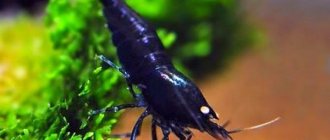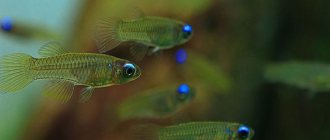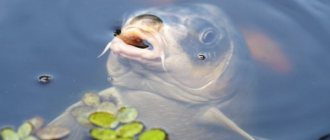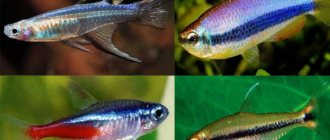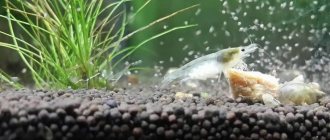Riley shrimp is one of the most unpretentious species to care for and maintain. Due to this, they take root well in virtually any clean water. Omnivores, can eat fish food, various cereals and chips.
Despite the fact that this type of shrimp is unpretentious, the basic requirements for life support cannot be neglected.
Riley: photo and description
As a species, Rileys appeared 10 years ago. They were bred from another species, the Cherry shrimp. For a long time, breeders were unable to combine a translucent body and bright colors. However, the Taiwanese specialist succeeded.
The very first Rileys were bred from red Cherries. Therefore, they had an uneven reddish color. In fact, they immediately gained popularity and were sold at a fairly high price. However, then the success took hold, Rileys of different colors began to appear, and the price fell.
Currently, the species has colors such as yellow, orange, black, blue, red, combinations, etc.
Riley's appearance
As mentioned above, this type of shrimp was developed relatively recently. First of all, it hit the European market. This new product reached the Russian market quite recently. Now this species is imported en masse, the most popular color is bluish, as it is rare.
Riley borrowed her appearance from Cherry's descendants. They had some mutations in color, which made it possible to encounter a wide variety of variations in nature. Thus, Rileys have a translucent body and bright colors.
Selection
In 1996, a new species of shrimp, Rili, was developed by Japanese breeder Hisuasu Suzuki in Taiwan. Kohaku shrimp is what the Riley shrimp is called in its homeland. The main breeds are:
- Riley carbon shrimp;
- Orange Riley;
- Red Riley;
- Yellow Riley.
The basis of breeding selection is a strict selection of colors, which combines the ratio of colored and transparent parts of the shrimp. The more transparent parts a shrimp has, the higher its class. Breeders are trying to obtain the ideal appearance of Riley shrimp: the belly is completely transparent, without color spots, and the cephalothorax is colored. Another direction is that the shrimp is completely transparent, and on the sides there are two symmetrical spots of red or orange.
Riley, with its ease of care, attracts a huge number of aquarists. This amazing creature appeared in Russia in the summer of 2004, and the aquarium shrimp became widespread in 2010.
Riley shrimp are available in the following variations:
- burgundy or red cephalothorax and tail;
- the cephalothorax and tail are burgundy or red, and the body of the shrimp is transparent blue;
- orange cephalothorax and tail;
- yellow cephalothorax and tail;
- black cephalothorax and tail, transparent or blue body.
Table of basic parameters of maintenance, care and nutrition:
| What should be the volume of the aquarium? | from 10 liters for 10 individuals |
| What should be the temperature in the aquarium? | from +18-28° C |
| What pH should it be | from 6.5-7.5 pH |
| What should the water hardness be? | from 4-14° dH |
| What should the substrate be? | thin grains of the substrate (soil) ranging in size from 3-4 mm |
| What kind of lighting should there be? | moderate |
| What should be the movement of water | moderate |
| Aquarium Shrimp Size | size of females up to 2.5 cm, males up to 1.5 cm |
| What does it eat? | zoo- and phytoplankton on moss; dead parts of plants; corpses of small fish; shrimp granules; live and frozen food; lightly cooked vegetables |
| Who is compatible with in an aquarium? | get along with small non-aggressive fish species and other types of shrimp |
| Lifespan | 2-3 years |
Maintenance and care
Rileys are extremely unpretentious in terms of maintenance and care. They belong to the freshwater class and can be kept perfectly in an aquarium. Moreover, many novice aquarists strive to get Riley, since it is impossible to spoil anything with them. This allows you to gain basic care skills and develop certain habits.
If you plan to purchase a group of shrimp of this species of 10 individuals, they will need approximately 10 liters of water. The size of one individual is approximately 2-2.5 cm.
Water hardness should range from 4 to 14° dH. The aquarium also needs to be equipped with various additions in the form of moss, some driftwood, and other paraphernalia. This is necessary so that the shrimp can hide during molting. And so that they have the opportunity to hide.
As for water filtration, it should be effective, and at the same time not create a strong current in the aquarium. Aeration is best. The water in the aquarium needs to be replaced approximately once a week with 30% settled water. The water temperature should be from +18-28° C. Acidity from 6.5-7.5 pH. With proper maintenance and care, Riley shrimp live for 2-3 years.
Freshwater shrimp have never been so popular among aquarists. Renowned neocaridine breeder Ade Dunn explains how to keep and propagate neocaridine shrimp.
The dwarf freshwater shrimp genus Neocaridina includes varieties such as red cherry shrimp (Neocaridina heteropoda var 'red'), white shrimp (Neocaridina cf. zhangjiajiensis var 'white'), blue shrimp (Neocaridina cf. zhangjiajiensis var 'blue') and also yellow shrimp (Neocaridina heteropoda var 'yellow', as well as orange, chocolate and a number of other color variations. Most are hardy and relatively easy to keep.
Where are they from?
Wild neocaridine shrimp are primarily native to Southeast Asia, living in streams and ponds, usually with lots of plants and often with twigs and rocks as natural substrate. However, most colored forms were bred artificially. Here are two diagrams showing how this happened:
What is the best way to keep them in an aquarium?
Neocaridina are usually best kept in well-planted aquariums with plenty of cover and moss. I noticed that they also love paludariums. Plants and decor provide the shrimp with cover and a surface for the necessary bacteria and other microorganisms, including edible algae, to live. It is an essential part of the shrimp diet.
I prefer to keep them in groups of at least six as they may become unsure in smaller numbers. A larger group also increases the overall gene pool.
Is there a minimum tank size?
Neocaridina shrimp have very small bodies and typically add little biomass to the aquarium, especially when kept with other tankmates. They can be kept in very small nano and pico aquariums, especially if they are well planted with aquatic plants (especially mosses) and with sufficient filtration, so they are popular in aquariums up to 15L in size. Anything less is not suitable for them, since six neocaridines can quickly turn into 100 in a short time!
This suggests that the larger the aquarium, the better. Use the largest aquarium that suits you. A larger volume of water will give you a larger "safe" buffer zone of temperature and water quality. Often the fatal factor for shrimp is a sudden increase in temperature, or a change in water quality, and smaller bodies of water are much more susceptible to sudden changes.
What water conditions do they need?
Any dwarf shrimp needs high quality water. Even a tiny amount of ammonia is fatal, and these creatures are also intolerant of nitrite. Therefore, they should only be kept in well-bio-balanced aquariums with fully “cycled” filtration.
Too much copper is also deadly to shrimp. You cannot use medications containing copper, and new plants should always be thoroughly rinsed to remove traces of copper after aqua-farming.
However, tiny trace amounts of copper, as found in many aquarium fertilizers and foods, are usually harmless unless you already have another source of trace copper. Your tap water may have quite high levels, or you may be overdosing on these recommended levels.
Most varieties of neocaridina require water with a pH of 6.5-8.0. However, when the water is too soft, calcium supplements may be needed to help the shrimp make new shells as they moult.
Regarding temperature - they live longer in the range between 21-26°C.
At higher temperatures, their growth and reproduction may be faster, but their life cycle will become significantly shorter due to the increase in their metabolic rate due to these temperatures. In warmer water you may also need additional agitation/aeration to compensate for the lower amount of dissolved oxygen.
What kind of fish can you keep them with?
I tend to keep my dwarf shrimp only with snails and other dwarf shrimp. This way you will see more of your shrimp out of cover with their natural behavior such as swimming on the surface and hanging from floating plants.
Among the safest fish that can be introduced to dwarf shrimp are Otocinclus catfish, which are generally considered safe for 100% of shrimp, even for newborns. Other species that may be safe for neocaridines are small Corydoras catfish and small loricarid catfish such as pleques, which usually remain quite small.
I have also kept shrimp with dwarf gouramis, small tetra species, small rasbora varieties, but this was in a tightly planted planted tank where the shrimp can easily hide but is rarely seen.
Won't they be pulled into my filter?
This is a common problem with internal or external aquarium filters, especially for juvenile shrimp. However, the problem is easy to solve. Either place thin, porous foam over the inlet, or cut a piece of fabric from a stocking and secure it to your filter tube with a rubber band.
If your filter's suction is still strong enough to suck in the shrimp and keep them inside, either adjust the flow rate if there is some kind of control on the filter, or stick a piece of wool in your filter to reduce the flow force.
If you have an external canister filter, don't panic if shrimp get sucked in. I often find colonies of cherry shrimp living happily in my filter, feeding on the bacteria growing on the media and safely hidden from the fish. As long as they don't get caught in the impeller they will usually be fine.
An alternative is air filter filtration, the most popular of which is the sponge air filter.
How do they reproduce?
No special steps are required to obtain neocaridina. If you can keep them alive and healthy, they will reproduce on their own.
Neocardine dwarf shrimp usually mate shortly after molting, with the female releasing pheromones into the water to indicate she is ready and this excites the males. A good sign in most neocaridine species that the female is ready is if you see a colored area at shoulder height. It includes the immature eggs visible through the shrimp's shell and commonly called the saddle.
Mating occurs between the shrimp facing each other, with the male depositing his sperm on the female's genital opening.
As the eggs pass through this opening, they are fertilized by sperm and then placed along the female's abdomen among her swimming legs (pleopods), where she will carry them until ready to hatch in three weeks to a month.
How do you raise the juveniles?
Neocaridine shrimp do not show parental care, and the juveniles are very vulnerable, measuring only about a millimeter in size. If they are kept with fish, it is very important to provide mosses and other places in the aquarium where they can hide and feed.
The offspring should be kept in a mature aquarium. The new one will not contain enough of the small organisms that young shrimp eat first, and this is a common cause of unsuccessful reproduction attempts. As they grow, the young shrimp will eat detritus particles, and they will also graze on any plants.
The water quality should continue to be kept consistently high, as should the temperature of their aquarium.
Which species are the easiest to keep?
All neocaridins are easy to care for. The simplest are probably the wild cherry shrimp (Neocaridina heteropoda) and Neocaridina palmata. However, snow and blue pearl shrimp are also fairly easy to care for and easy to breed, but can be more sensitive due to the inbreeding required to fix their color forms.
Why do they sometimes die for no reason?
The simple answer is that they don't do it without a reason - we just don't understand or find the reason. However, there are several possible reasons for their death:
- Old age: Neocaridina shrimp rarely live longer than 12 to 18 months, so if you buy fully grown shrimp, they may already be old.
— Copper poisoning: have you changed the brand of fertilizer or its dosage regimen? Perhaps you added new plants or used water from a hot tap during a water change? Did your shrimp show signs of lethargy before dying?
- Molting Failure: This is a very common ailment where a shrimp starts molting and then disappears without a trace. Possible causes could be a lack of calcium or iodine in the diet, so if this occurs, consider supplementing with foods containing these elements. Most crustacean and shrimp feeds contain additional iodine and calcium, often in the form of iodized algae.
- Too high levels of CO2/not enough dissolved oxygen: before they died, did your shrimp spend a lot of time near the surface or "surfing" in the flow from your filter? If this is the case, consider increasing the aeration or, if using CO2, check the level of dissolved gas in the water. If too high a carbon dioxide level is detected, reduce the supply.
— Decrease in water quality. Have you recently changed the media or washed your filter? If so, check your nitrite and ammonia levels as a small ammonia spike may occur and kill your shrimp.
- Predation: in fish or larger predatory shrimp, they may become prey to persecution. Being “scared to death” by an aggressive fish is entirely possible.
— Diseases: little is known about them and without special examination the disease may be difficult to detect. However, as a general rule, if your shrimp are kept in good conditions, you will rarely encounter any illnesses.
Video
What is a shrimp tank? Basics
Cherry shrimp (cherry), sakura (green, orange, black)
Aquarium shrimp: filter shrimp (banana), amano, Indian (zebra), rednose (pinocchio)
Aquarium shrimp: Neocaridina davidi, Riley (red, black, orange, blue)
Shrimp: crystal, bee, panda, green, king kong, red ruby, blue bolt
Red Rileys
What to feed your Riley shrimp
What and how to feed shrimp in an aquarium with and without fish. Due to its unpretentiousness, the issue of nutrition is not particularly acute. You can adhere to the golden rules of feeding ordinary fish. They are able to feed on algae, dead and rotting plants, and fish food. Cereals or chips, ground into small pieces, work well. The shell will also be eaten after molting - it is a source of nutrients.
However, you cannot always adhere to such a diet. It is necessary to draw up a special schedule that will reflect the frequency of introducing special feeds.
The essence of special food for shrimp is to saturate the shrimp with animal and plant ingredients. In addition, they contain scalded leaves of spinach, lettuce, boiled and chopped green peas, and pieces of vegetables.
It is worth determining one or two days a week that will be fasting. This approach to nutrition will allow shrimp to grow and develop systematically, without experiencing the need for certain nutrients.
How to determine gender
To distinguish what gender a particular individual is, you must first wait until they reach sexual maturity - this is around 3 months of age.
It also helps to determine the sex that the female has a “saddle” on her back and females are larger than 2.5 cm in length. Females stand out from the general background of a group of shrimp, and it will not be difficult to find them. Males do not grow more than 1.5 cm in length excluding whiskers. In addition, the color of females is brighter than that of males.
Most of the males are endowed with very pale paint, or even barely noticeable on the translucent body.
You can also determine gender by behavior, but this will require observation. Females are slower and most often move along the bottom. While males try to explore every corner of the aquarium. They often enter into conflict situations with other males over food, but this behavior can also occur in females. As a rule, all situations of this type end peacefully, since there is enough food for everyone, and they quickly notice this.
Cohabitation
Along with Riley, other types of shrimp can inhabit the aquarium.
Important! It is not recommended for fish and shrimp to live together. Most fish perceive crustaceans as food due to their size and appearance.
It is strictly forbidden to keep the following types of fish in the same aquarium with shrimp:
- gourami;
- swordtails;
- platies;
- Molinesia;
- loaches;
- carp-toothed species.
You can choose guppies or neons, but they can also show aggression towards these shrimp, especially if the latter are still young.
In any case, Rileys are very bright and attractive, and therefore you can give them a separate aquarium. Learn how to properly start an aquarium, give it a beautiful background and install a heater.
Riley shrimp: reproduction, breeding
The first factor to pay attention to is the quality of the water in which the shrimp are kept. It must be clean, only in this case the shrimp will reproduce regularly. The female of this species carries eggs for 20 to 30 calendar days. As soon as this period passes, small shrimp hatch from the eggs, looking very similar to their parents.
Before small shrimps are born, it is necessary to take care of their safety. The water filter should be equipped with a piece of foam rubber to prevent small creatures from being sucked into the filter.
Feeding and care are exactly the same as for adults, except that small shrimp are very slow due to their young age. Therefore, you need to introduce food pointwise and several times so that they definitely get it.
Compatible with fish and other shrimp
Riley shrimp can get along quite well with their neighbors in the aquarium. They can be kept with a wide range of fish and shrimp species:
- dwarf gourami;
- Neons;
- Guppy;
- Danio;
- neon irises;
- Parotocinclus and many other peaceful, small aquarium fish.
The only conditions are that the fish must not be predatory:
- large Cichlids: Maingano, Cornflower and other species;
- angelfish: Marmorna, Veil, Altum and other types;
- apistogram and many other predatory aquarium fish.
Riley reacts to the presence of neighbors in the aquarium with the color of their body, their color intensifies somewhat. As a rule, they do not conflict with each other. The only exception can be territory.
Where do they come from, these bright shrimp Neocaridina davidi?
We already know from the previous article that under natural conditions, Neocaridina davidi shrimp have a nondescript gray-green color. Using the method of careful selection for color characteristics and color fixation by crossing selected shrimp individuals, breeders genetically bred different variations with different phenotypes and colors. When breeding davidi shrimp, the hybridization method is not used. Here are just some of the names of such shrimp:
- Neocaridina davidi var. (varius translation from Latin - variation/option) Yellow;
- Neocaridina davidi var. Orange Sakura;
- Neocaridina davidi var. Red Sakura;
- Neocaridina davidi var. Red cherry;
- Neocaridina davidi var. Riley Dotted;
- Neocaridina davidi var. Green;
- Neocaridina davidi var. Yellow;
- Neocaridina davidi var. Blue-Orange Riley;
- Neocaridina davidi var. Blue Riley
You need to understand that trade names may change depending on the country, but the names of the genetic variations to which different individuals of shrimp belong should not change. Below are tables of color variations of Neocaridina davidi. In the two tables you can see different genetic selection lines. Each genetic line in turn has different qualities in terms of color intensity and distribution.


